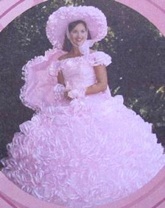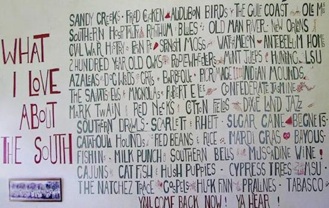Or… In the spring, a young man’s (and a middle-aged couple’s) fancy turns to the Deep South.


And springtime in the land of dogwood and azaleas and redbud and wisteria……..? No surprises: it really is lovely; if the south stayed like this year-round, we sure would hang around here more. Coming out of Texas around the first of March, we made a deliberate decision to see what pleasures the south had to offer, and we haven’t come up short.
In the past, Louisiana, Mississippi and Alabama have, for us, largely meant the stretch of I-10 that quickly whips you through the southern edges of these states; we wanted to see what else was out there. We bounced back and forth some, wanting to attend certain events, and we are now having an out-of-area experience traveling up through Tennessee to Kentucky, visiting old buddies Tom and Pat Wardell, recently removed from Arroyo Grande to Louisville; otherwise we stayed “down deep.”
On earlier trips, Louisiana is a state we have tried to like, without much success. So we figured, “Let’s start with Louisiana, and give it every chance to show its best side.” The state’s roads aren’t very good, which has always put us off; and that didn’t change much. Other poor regions have been putting money into their highways (Mississippi is a very good example), but Louisiana seems to have other priorities. Wherever we traveled, we were always muttering (and Agnes was hollering) about the bumpiness.

Continuing along the River, we spent a little time in Baton Rouge. That’s all it really takes; Baton Rouge doesn’t have a lot going on, although it’s the state capital and the home of LSU. We visited the capital building, which is really beautiful, discussed the man who got it built – Huey Long – and promptly went out and bought a copy of Robert Penn Warren’s All the King’s Men. That book is a joy to read, if you haven’t picked it up since college days; Warren was a gifted writer. Pulitzer people seemed to think so, too.

A word about traveling along the River: you cross it over and over and over again. Sometimes on big bridges, sometimes on teeny ferries. We did a couple of the latter and it was quite an experience. The locals are REALLY local. They sit in their junky old cars and drink during the crossing; the hunters have big dirty trucks with ATVs and caged dogs in back; it was really interesting. These ferries are family-run operations, and we’ve chatted with some really nice folks, but you do get a taste of real life. We passed many fields meant for sugar cane (they were dormant) and enormous oak trees that were all that was left of plantations, and tiny towns with old cemeteries (yes, the vaults were all above ground). And of course the River isn’t where it used to be. If you look at a map, you can see oxbows and isolated curves of water that are not connected to the course of the modern-day river. Gets really weird when you consider that the state boundaries were drawn to coincide with the path of the water; these days the River wiggles and not waggles, and has left parts of states high and dry on the wrong side of the river, but the boundaries have never been adjusted.

We briefly considered heading up to Natchitoches, Louisiana, an area we very much would like to explore, but decided the great state of Mississippi was calling us. So we headed up to the Natchez Trace.

While in the state we’ve spent a goodly amount of time exploring the area along the river. Natchez is a town famous for its antebellum homes and historic atmosphere. We arrived at the beginning of Pilgrimage season, and there was lots of activity. We had a great lunch at the Pig Out Inn (“Swine Dining at its Finest”), where we discovered the wall you see replicated above. “’What I Love About the South” is painted all over one end of this little lunch joint. The food was yummy, too. We wandered around town while Rick did his best to fulfill my yen for the perfect dogwood tree picture, visited the national cemetery there, checked out the Visitor’s Center (where a very earnest lady was absolutely incensed that I didn’t want her brochure on the Pilgrimages – “you are the second one this week”). Natchez sits on a bluff, and there are lovely views of the river; a pretty town to visit, but they were disturbingly anxious about our need to spend money there. Pilgrimages are expensive, and we don’t like being herded along seeing stuff, and had decided to skip the whole deal.

Woodrow’s Butt Paste – “It’s not just for rashes” – sign somewhere along the way – honest, we don’t make these things up.
We touched base in Vicksburg, which we had visited before; unfortunately it shares a problem with many other medium-sized towns: what to do to keep people coming, but save your old streets and “charm.” Vicksburg needs to work harder. They have several roads sort of circling the area, all with shopping malls or attractions (universally ugly), and it’s hard to have a quality experience. A very important battle took place there (see above), but it is not one our favorite civil war sites. The park was laid out around 1900 along the confederate and union lines from during the siege but we find the available information to be sketchy and not very well presented. The national cemetery there was, however, lovely and a delightful place to visit, and a newly completed museum dedicated to the river gun boats of the war looked very nice. We moved on.
Jackson is the capital of Mississippi; the new capital building was constructed in about 1903 and is historic itself, but we satisfied ourselves by visiting the museum that has been made out of the “old” capital, built in the 1830s. it was a grand old building with good displays, and worth a visit. There we saw, in a history of the state, what was annotated as the earliest display in history discussing the civil rights movement in the South. It was surprisingly straightforward, with newspapers and film footage that clearly showed blacks being manhandled, photos that still make us uncomfortable; Mississippi isn’t dodging its responsibility here. I have a southern branch of my family, and Miss America of 1957 (Mary Ann Mobley, even if you don’t care) was my cousin. I was invited to come south and attend Ole Miss when I was considering schools (UC Davis won out quite easily, of course); I wouldn’t have lasted 6 months down here.


Abandoning Tupelo for better parts, we had promised ourselves a visit to Oxford, home to (the aforementioned) Ole Miss; also the prettiest courthouse square in the universe, a killer bookstore that’s in the first building constructed after the end of the Civil War, tons of lovely old homes, and Rowan Oaks, where William Faulkner lived and wrote. We fell in love with this town; about 15,000 people, still charming and quiet, full of ancient tree-lined streets; a delight. We could have stayed forever, but it was only a day trip on the motorcycle. As we were leaving, we had a from-another-dimension experience. We stopped for gas, asked the girl at the nearby pump for some directions on getting out of town, and got an earful. She is an English major at the college, had come here because it was such a special town; she kept insisting that the town had taken Faulkner’s body and had it bronzed after he died, and had set the body on a bench in front of the town hall where people could sit and talk to him. She swore it was true, and if false that three different professors were lying to her. Bizarre! But she was cute. Her boyfriend just kept looking at her and rolling his eyes.

Why go to Alabama? Why not? Our tour of the deep South in the springtime needed a Tuscaloosa-Birmingham stop. Birmingham is a large city, and we will be back in May for some motorcycle races, so we contented ourselves with a visit to the (very nice) Museum of Art, which had a special exhibit on French baroque and French impressionist paintings. A good time was had by all. We also spent a nice hour at Rickwood Field, the oldest extant baseball field in the United States. It was built in 1910, and was the home of minor league and negro league teams including the Birmingham Black Barons, who won a league championship in 1948 featuring a then 16 year old outfielder named Willie Mays. Several years ago, a group formed a foundation in order to restore the site, and slowly they are returning it to its glory. It has continued to be used by local leagues, although it was abandoned by the local minor league team, the Barons, in the 1980s. What is so cool, though, is that it is wide open for a visit, the field is in beautiful condition, costs nothing, and you can walk out onto the diamond, stand on the pitcher’s mound, and see where Hank Aaron, Satchel Paige, Ty Cobb, Babe Ruth, all stood and played.

Then we trekked back into Mississippi, which was just fine with us; we were on our way to a motorcycle rally outside Vicksburg, and it was a great three days. We were camped in a small, isolated rural area not far outside town, which was truly lovely (although Rick never did get motivated to take any pictures), complete with pond, ducks and geese everywhere, the family (one) deer, horses, etc., very relaxed group, southern BMW riders, with good food and music; we made some new friends and had a swell time.
Our time in Mississippi was drawing to a close. We started swinging north to head up into Tennessee and eventually Kentucky. But first we wanted to investigate the Mississippi Delta, home of cotton, catfish and the blues (at least that’s what each and every brochure on the area tells us). Well, it’s a mixed bag. As you move north along the River from Vicksburg, the countryside begins to flatten out (the delta). Lots of fields waiting to be planted, lots of catfish ponds (some being harvested), and not much else. We stayed overnight in a small park right on the River, one of the few spots where there isn’t an enormous levee between you and the water. It was pretty, and we enjoyed watching the barge traffic going up and down day and night. We visited Leland, the home of Jim Hensen, because there’s a Kermit museum there…..but it was closed. We went through the town of Hushpuckena, but didn’t even notice it. You can see we weren’t overly impressed. Our major goal for the morning was to visit Clarksdale and check out the Delta Blues Museum. This is big time blues country. But we were stymied. Clarksdale is a really, really old town. As you come into town, you have to go under a train overpass; there was a huge sign saying 11’ 6”; wellllllll, we’re about 11’ 2’; and that’s toooooo close. So we paralleled the train tracks until we could find a crossing, and headed back into the “downtown” area. But circle though we might, we never found another sign to the museum, and ended up out in the countryside again. Maybe we’ll try another time. And for you cognoscenti, no Morgan Freeman to be found. Frump.
Sign along the road advertising a herbicide: “Root not, Nematodes!” And a real estate company called Krye-Leike Realty; now don’t you think they could have changed that to a better name?
We were feeling a sense of urgency anyway. A hose on the chassis air conditioning had failed, and we were on our way to a repair shop that, hopefully, could solve the problem for us. This would in time bring us across Tennessee, seeing more of this favorite state than we would have otherwise, so no ill feelings to be found. So we leave you here, dear readers, knowing that “Springtime in the South” is indeed a worthy goal. It was delightful, full of lovely flora and countryside, beautiful homes, gracious folks who are happy to make your acquaintance; everything you could wish for. And the hush puppies are delicious.
Happy Spring to all of you. Let us know what you’re up to, what plans you’ve made for this year, and if we might be able to get together. And a special question to the “Why Things Are” guy: why is red bud purple?
Rick and Kathy and the shedding kittycats
P.S. The butter is back in the fridge; the extra blanket has been put away, gotten out again and put away once more; and our faithful little catalytic heater the same. It’s spring and the only thing for sure is the weather it is a changin’.





